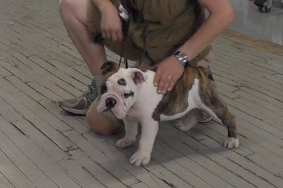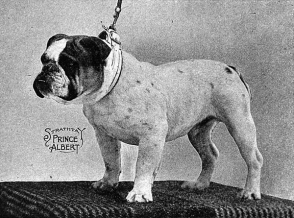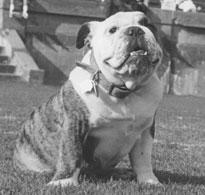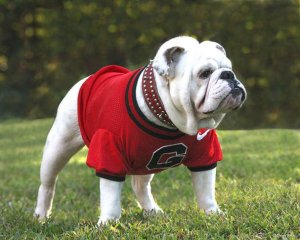You are currently browsing the category archive for the ‘news’ category.
No Pekingese. No Bulldog. No Clumber Spaniel. No Mastiff. No Neapolitan Mastiff. No Basset Hound.
These are the breeds that were absent within their respective group competitions at this year’s Crufts, due to their chosen ambassadors (those judged Best of Breed) subsequently flunking a newly mandated vet check.
According to the Kennel Club website:
The Kennel Club has introduced veterinary checks for the Best of Breed winners at all Kennel Club licensed General and Group Championship Dog Shows from Crufts 2012 onwards, in 15 designated high profile breeds. This measure was introduced to ensure that Best of Breed awards are not given to any dogs that show visible signs of problems due to conditions that affect their health or welfare.
The fifteen high profile breeds are as follows: Basset Hound, Bloodhound, Bulldog, Chow Chow, Clumber Spaniel, Dogue De Bordeaux, German Shepherd Dog, Mastiff, Neapolitan Mastiff, Pekingese, Shar Pei, St Bernard, French Bulldog, Pug and Chinese Crested.
Thus no Best of Breed award was ultimately awarded to the winners of six individual breed contests. See all results here.
One can read more about these events on a number of sites, including Terrierman’s Daily Dose, Pedigree Dogs Exposed, Border Wars, and Honest Dog.
Personally, I applaud the Kennel Club for taking this step, although they may have done so grudgingly, and although it is perhaps not the best step they could have taken. And I applaud the veterinarians in question for their willingness to suggest that the Kennel Club’s “Best”– if that includes dogs suffering from visible health problems– isn’t good enough.
But I’m a little put off by the Kennel Club’s apparent effort to lay blame for the crippling health problems within certain high-profile breeds squarely at the feet of a handful of judges. And I’m equally put off by the suggestion that the solution to these problems, which clearly stem in large part from a century of judging dogs by appearance alone, is somehow to judge dogs more competently by appearance alone.
From the Crufts website:
Ronnie Irving, Kennel Club Chairman, said: “The majority of people involved in showing dogs, including the 15 high profile breeds, are doing a good job in moving their breed forward and many judges are ensuring that health is paramount when they judge. This work should be applauded and recognised.
“Sadly though, a few judges in some breeds simply can’t or won’t accept the need to eliminate from top awards, dogs which are visibly unhealthy. Neither we who show dogs, nor the Kennel Club which must protect our hobby, can reasonably allow that state of affairs to continue. I hope also that monitoring the results of this exercise may even, in time, enable us to drop from the ‘high profile’ list some of those breeds which prove to have a clean bill of health.
“This move, along with the other health measures that we have put in place will help the Kennel Club to ensure that the show ring is, as Professor Patrick Bateson said it can be: a positive lever for change in the world of dogs.”
Professor Steve Dean, Crufts Committee member and Senior Veterinary Surgeon, and a member of the Kennel Club General Committee, said of the new requirements: “The guidance which we will issue to Show Vets will focus on clinical signs associated with pain or discomfort which will come under the main headings of external eye disease, lameness, skin disorders and breathing difficulty. The show veterinary surgeons will be looking for signs such as ectropion, entropion, corneal damage, dermatitis, breathing difficulty on moderate exercise, and lameness. The fifteenth breed is the Chinese Crested where the principal issue will be the presence of skin damage arising from hair removal and thus signs of clipper rash or chemical insults to the skin will be looked for.
According to Kennel Club secretary Caroline Kisco, the vets will be judging the winners’ health solely by outward appearance. In other words, vets are not to disqualify dogs for any reasons beyond those that would have been apparent to the show judges themselves. Watch the below video to hear Kisco explain in her own words.
Here’s my take on that interview. By scapegoating individual judges, the Kennel Club deftly avoids undermining the idea that purebred dogs may be perfected via beauty contests. After all, a competent show judge should be able to gauge a dog’s health and fitness just as easily as these independent veterinarians, right?
It’s not the system that’s broken, it’s not the bizarre dog show culture, and it’s certainly not the Kennel Club ethos. It’s just a few bad apples– a few blind or deluded individuals that somehow can’t tell a sick dog when they see one.
Other than that, everything’s fine.
© Ruth Crisler and Spot Check, 2012.
A few of you might remember a post from around two years ago regarding an obvious hoarding situation masquerading as a cat sanctuary. The post was titled WTF?, which should provide a clue as to my take on the matter.
According to the ASPCA, Caboodle Ranch was the subject of a year-long investigation culminating in last week’s arrest of its owner Craig Grant, and the removal of 700 cats from its premises.
Below is the fluff segment, posted on YouTube, that originally caught my attention.
The New York Times published this article on bulldogs last week. Better late than never, as they say.
They really can be charming dogs, I admit. I know a whole bunch and do adore a number of them. It is also an inarguable fact that they make some of the most freakishly cute puppies on the face of the planet. But I nonetheless routinely caution against their acquisition, along with hoards of fellow dog trainers, for a multitude of reasons including heart, joint, and breathing problems, debilitating allergies, and short lifespans.
Examining the progress of the breed over the past century explains a lot. Below is an illustration from the NYT article depicting the evolution of the University of Georgia mascot “Uga”, followed by some photographs I found online.
For a more in depth take on the NYT article, see this recent post at Pedigree Dogs Exposed.
I was jarred over the weekend to discover the Certification Council for Professional Dog Trainers had lately revised its 2009 policy statement on training practices.
Back in December, I’d written a letter to the CCPDT’s Board of Directors protesting the inclusion in that statement of language banning certificants from using electronic collars on any dog under one year of age. The letter had accompanied my application to re-certify as a CPDT-KA, and explained why I could not sign on to the new policy.
My check was ultimately returned and my certification allowed to expire. But that decision was not made hastily. The CCPDT Board took two weeks to consider my case, a fact that was communicated through official channels and leads me to believe that everyone serving on the CCPDT Board at that time would have read my letter.
And despite the scant response I got at the time, it appears the CCPDT Board may have taken my concerns (or similar concerns voiced by others) to heart.
As of August 4, 2011, the CCPDT’s Policy on Training and Behavior Intervention Practices no longer includes the following within its list of disallowed practices:
Applying a collar that delivers an electrical stimulation to a dog under the age of one year, with the exception of a vibration collar that does not have an electronic shock component.
In its place, a new and unrelated restriction has been added:
Purposely lifting a dog by the collar, leash, or scruff such that two or fewer of the dog’s legs remain on the ground.
Go figure.
Or, follow this link to view the revised policy statement in its entirety.
By the way, it’s unclear to me whether the CCPDT has actually shared the fact of these changes with current certificants, apart from editing the document as it appears on the CCPDT site. You would think they’d be obliged to, kinda-sorta, considering a new restriction was introduced. But the person who brought these changes to my attention said she’d only happened upon them by accident while reviewing the policy online. And it was definitely not mentioned in the most recent news update posted to their site.
A fact I can confirm unilaterally is that they did not inform me. But that’s not so shocking.
© Ruth Crisler and Spot Check, 2011.
As western civilization reels amid shocking revelations that due to the earth’s wobble, most of our astrological identities have in fact been wrongly assigned, you might consider laying down your allegiance to your star sign, and picking up a Chinese calendar.
The Chinese zodiac identifies us according to the lunar year in which we were born. There are twelve lunar signs in all, honoring twelve animals. Origin stories differ, but the Chinese zodiac remains the same, wobble or no wobble. At least that is my current, wholly unscientific understanding.
I am a Dog, incidentally. Happy New Year!
© Ruth Crisler and Spot Check, 2011.
Disclaimer: I know nothing about penguins. But I know a thing or two about equipment.
My husband called me from his car to alert me to a story on NPR he thought I needed to hear. I think his exact words were, “So, I’m listening to the radio, and there’s a penguin expert complaining about a new scientific study, and she sounds exactly like you. And she sounds really pissed.”
Huh??
He was right, though. Her comments in response to the penguin study, the results of which are published in the current issue of the journal Nature, sounded eerily like my comments in response to a number of “shock collar” studies I’ve read. And, in another striking parallel, her tone did come across as rather annoyed.
The study, conducted by a team from the University of Strasbourg in France, claims to answer conclusively the question of whether the flipper bands used by scientists to track penguins in fact significantly compromise their chance of survival. From the radio transcript:
The French team put traditional metal bands on 50 King penguins that live near Antarctica. Fifty others had much smaller radio-frequency transponders. Ten years later, the survival rate for banded birds was 16 percent below the unbanded birds.
Yvon Le Maho, the chief biologist, says at first there was little effect. Then during the first 4.5 years, survival rates for the banded birds dropped about 30 percent below the unbanded birds.
“In other words, only the superathletes are surviving,” Le Maho says.
The numbers were even worse for breeding, banded birds producing 39% fewer chicks.
Le Maho found that banded birds took longer to forage for food in the ocean and they were slower to get to breeding sites in the spring. That meant adults had less time to raise their chicks before heading off for lengthy foraging trips in the winter.
“At some time, they have to leave while their chick is too young and too poor in [reserves of] body fuels to withstand the winter,” Le Maho says.
According to ukwired, the “[French scientists] say continuing to use the tags would in most situations be unethical.” This despite other studies that show such bands to have minimal effect.
“There was a debate about whether bands have an effect or not – and you could find studies and some would say ‘yes’ and some would say ‘no’,” said Claire Saraux from the University of Strasbourg and the French Centre National de la Recherche Scientifique (CNRS).
“So our idea was to try to make sure – instead of doing one-year studies, to try to find out what’s going on over 10 years,” she told BBC News.
This study… eclipses everything else”
Case closed, non?
But what about that lady on the radio that sounded like me? Dee Boersma is described as one of the world’s leading penguin experts, and it turns out she has a different opinion. From the NPR transcript:
The French study, she says, “shows that the bands that they used on King penguins harmed the King penguins — I have no doubt about that. But all bands are not created equal. It depends on what material that they are made of, it depends on how they are shaped, it depends on how they are fitted to the individual penguin. It depends on what penguin species it is.”
Mais, non?!
You mean to tell me that all nifty flipper bands are not in fact the same? That the “traditional” bands used in the French study may not fairly represent all such bands? That maybe an aluminum band is mare harmful than a plastic one? That how the bands are applied in the field actually has some relevance? Sacreblue!
But listen for yourself:
http://www.npr.org/2011/01/12/132859946/flipper-bands-can-harm-king-penguin-population(and if that embed doesn’t work, follow the below link)
Flipper Bands Can Harm King Penguin Population
Oh, and just one more note on the above penguin study. It seems that if we take its results at face value, it may undermine previous studies on the effects of climate change, which have used the survival rate of tracked penguins as an important barometer.
What’s my point? It is that science, at least as practiced by mere humans, is often fallible, and rarely Godlike.
That said, it does seem logical that putting even a minute drag on one of a penguin’s flippers would have some ill-effects over the course of its lifetime, which I understand can be up to 20 years or more. And I agree that this is a problem, both for the penguins themselves, as well as for our ability to take meaningful data from our study of them.
The question is regarding the true scope of this latest study. Its authors claim it is “conclusive,” and that it “eclipses” all previous studies. But is demonstrating scientifically that something can do harm equivalent to demonstrating that it will do harm in a majority of cases? I would say no.
© Ruth Crisler and Spot Check, 2011.
Dog trainer Dick Russell died early Thursday morning, in the company of family and friends.
Dick Russell’s Yielding article has been an essential handout for new students at See Spot Run for a number of years. I know it almost by heart, and I knew Dick Russell as many did, as a renowned dog man and passionate teacher. But apart from his writing and reputation, I didn’t know him.
I never saw him work his magic on a dog, command the rapt attention of his students, nor conduct his famous Large Field Socialization. I never helped him tend his vegetable garden, nor his chickens, nor his kennels.
I never shared a meal with him, nor a bottle of sherry. We never exchanged stories, never stayed up late. I never tasted his cooking.
I also never finished the letter to him I began writing one evening, in the wake of one of his more colorful and lunatic posts to a certain trainer list, in which I meant to ask if the invitation (to anyone interested in seeing LFS in action) to visit him in Louisiana, was in fact still open. I never mailed that letter, never made that pilgrimage.
I wish I had.
They say that in the end, you mainly regret what you didn’t do, and I believe it. My guess is, Mr. Russell had very few such regrets.
He did have near limitless confidence and generosity, and as true an understanding of dogs as any man is likely to achieve in one lifetime, by the testimony of those who knew him best, and as evidenced in the following guarantee published on his website.
The World Famous
Dick Russell
” Whatever It Takes For The Life Of Your Dog”
Training Guarantee
That’s the guarantee. It’s simple, straightforward and I mean it. My reputation depends on your success with your dog.
There are some things I would like for you to do to make this guarantee work.
Should you encounter problems with your dog while you are training, telephone me. We will discuss the problem and I will advise you. If this does not solve the problem, I will come to your home and help you. If we can’t schedule a time for this, I will meet you before class, either at your class site or at one of the other locations. If this should prove impossible, you can come to my home for individual help.
Should you miss a class, telephone me. It is not fair to either you or your dog to come to class having missed the foundation for that night’s lesson. We will somehow schedule a makeup lesson for you.
Should you find it necessary, for any reason, to drop out of classes before you have completed them, you can, at any later time, re-enroll at no cost.
You can repeat the basic class as many times as you wish.
You can bring your dog back for refresher training whenever you wish.
You can train in the advance class at no charge.
You can participate in the Socialization class at no charge.
Should another family member wish to bring the dog to classes at a later time, there will be no charge.
Should you need to give your dog away, the new owners can bring him to class at no charge.
All the dogs in your household can come for the price of one. This applies only to the dogs you have when you enroll. There will be a full charge for later acquisitions.
This is not the limit of my guarantee. If these things do not get the job done, we will improvise. When I say that I am committed to you owning a wonderful pet, I am as serious as a heart attack.
Spot Check passed a minor milestone last night while I was sleeping: 10,000 hits.
When I began Spot Check last March, I viewed its purpose as twofold. First, it was an outlet for years of pent-up (or only privately shared) opinion on dogs and dog training. Second, it was a commitment to write, which is something I dimly recalled doing a bit of in school and shortly afterward, and had always meant to resume but never had.
But it is more that that. It has put me in touch with other trainers, both professional and amateur, and provided a forum for friendly debate and open exchange among skilled and thoughtful people. In some cases, your comments have challenged my opinions and caused me to re-evaluate what I think I know.
That was really my hope all along.
This will also be my 50th post. Not bad for a wife and mother of two with a kennel to run. Granted, not all of them were gems, but nobody’s perfect.
I thank everyone who’s taken the trouble to peek at this blog over the past ten months. And as always, I look forward to your comments.
I grew up in a commuter town in New Jersey known for its faux-tudor houses, devil-worshipers, and radon.
As a teenager, I spent an inordinate amount of time traipsing up and down Manhattan, taking classes at the Art Students League, and missing the last bus home. I still miss NYC at times, and make sporadic efforts to stay abreast.
This post has nothing to do with dogs, and may be offensive to some. Word to the wise.
It has to do with Ground Zero, or the real estate surrounding it, where a nominally local dispute over the proposed erection of a Muslim community center has lately ignited an international debate.
I don’t intend to rehash it here.
I will only comment on an argument encountered Friday night while wading through the political blogosphere: that had strippers flown the planes that destroyed the World Trade Center, they would not be welcome on such hallowed ground, either.
This is the preferred resolution, it seems, to the conflict created by the widespread insistence in recent days that some undetermined amount of real estate peripheral to Ground Zero be counted as hallowed, despite its meanwhile playing host to strip clubs, peep shows, and off-track betting.
It’s been a while since I lived in the tri-state area, but last time I checked, hallowed ground wasn’t subject to byzantine zoning codes.
hallowed: adj 1. holy, consecrated 2. sacred, revered
Just double-checking. So how does this jibe with accommodating sex shops, lap dances, and gambling?
Let’s see how author and acclaimed journalist Abigail Esman explained it Friday in her Forbes blog Pen & Sword:
Rauf [the man steering the proposed development]– and others – note that strip joints and OTB offices occupy the space nearby Ground Zero, and argue that this proves, somehow, that the area is not considered “hallowed ground.” This, of course, is idiocy. Strippers didn’t kill 3000 people that day; Muslims did. Strippers don’t threaten to destroy America if we don’t build a temple to nudity where they want us to; Muslims do. Had strippers and gamblers been the ones who plowed their planes into the Twin Towers and the Pentagon, you can bet they’d not be welcome there now, either.
I forget the Latin term right now for HUH???? But it will come to me.
In any case, I know basing one’s argument on a purely ludicrous hypothesis is not considered entirely kosher among bona fide logicians. And I would note that presuming that one’s opponents spout idiocy falls somewhat short of actually demonstrating it.
I also question her basic presumption. I mean, how totally convinced are we that strippers would be unwelcome? No doubt whatsoever? Not even really kickin’ ones?
Okay, what about cab drivers? If cab drivers had flown planes into the Twin Towers, would they now be unwelcome within a two block radius of the footprint?? You see my dilemma.
As an aside, I do think Esman’s startling hypothesis has the stuff of a really solid premise for old-school science fiction. What if….
This may be the biggest problem with Esman’s red herring–the imagery it conjures, which is both bizarre and distracting, as well as a teensy bit hard to shake. Face it, when your head is spinning with visions of scantily clad terrorists deftly twirling their tassels as they overwhelm the cockpit, focusing on the earnest intent behind words such as these becomes genuinely challenging:
Like the papers that wind whisked that day as far as to downtown Brooklyn, Sabella’s body, it seems, simply blew away. His remains could still be buried in the earth deep below the WTC foundations – or, more likely, they fell as ashes, not so far away–perhaps, indeed, where the Burlington Coat Factory still stands.
…or on the stage of the Pussycat Lounge.
Maybe lower Manhattan’s sex stores, strip club, and OTBs got grandfathered in as acceptable “special uses” on its hallowed ground, sort of like the slaughterhouses within Chicago’s Planned Manufacturing Districts (also most hallowed, by the way).
My own conviction is that there is no graceful way to rationalize declaring the ground in question to be hallowed, when no one has treated it as such before now.
And for the record, I am neither a prude, nor an enemy of the state.
© Ruth Crisler and Spot Check, 2010.
















Recent Comments